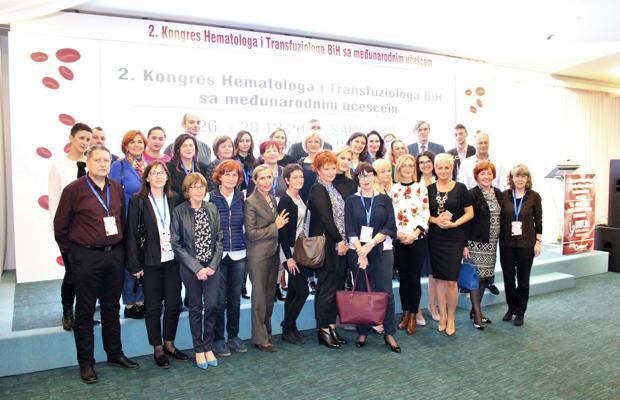5-Year Follow-up Confirms Nilotinib Safety and Superior Efficacy Compared With Imatinib in Newly Diagnosed CML in Chronic Phase
• 5-year follow-up of ENESTnd: randomized, open-label, multicenter phase III trial[1]
Summary of Key Conclusions
• With 5 years follow-up, nilotinib provides superior efficacy compared with imatinib for newly diagnosed patients with chronic-phase chronic myeloid leukemia (CML)
o Significantly higher rates of early molecular response (EMR), major molecular response (MMR), and deeper molecular responses including molecular responses ≥ 4.5 logs (MR4.5)
o Reduced risk of disease progression to accelerated phase (AP)/blast crisis (BC)
o Trend for improved PFS and OS
• Landmark analysis, EMR at 3 months, significantly associated with improved PFS, OS, and MR4.5 at 5-yr follow-up
• Nilotinib associated with acceptable safety profile with 5-year follow-up
o However, nilotinib associated with more cardiovascular events compared with imatinib
• Long-term efficacy and safety data confirm nilotinib 300 mg twice daily as standard of care for patients with newly diagnosed chronic-phase CML, according to study authors
Background
• Nilotinib is a highly potent and selective second-generation tyrosine kinase inhibitor
• ENESTnd trial: frontline nilotinib in patients with CML
o 4-year follow-up showed higher rates of molecular responses—including deep molecular response regardless of Sokal risk score—and decreased rates disease progression and CML-related deaths with nilotinib compared with imatinib (Capsule Summary)[2]
• Current analysis provides 5-year update of nilotinib efficacy and safety compared with imatinib based on longer follow-up[1]
Schematic of Study Design

Eligibility
• Newly diagnosed
• Philadelphia chromosome–positive chronic-phase CML
• ≤ 6 months from diagnosis
• ECOG performance score 0-2 with adequate organ function
• QT interval correct formula < 450 msec
• Previous CML therapy not permitted, except
o Hydroxyurea
o Anagrelide
o ≤ 2 weeks of imatinib
Patient Disposition
• Median time on core treatment comparable between arms
o Median dose intensity similar to intended dose for all treatment arms
• Few treatment discontinuations since 4-year follow-up, with 3.5% (n = 10) on nilotinib 300 mg, 4.3% (n = 12) on nilotinib 400 mg, and 6.0% (n = 17) on imatinib
o 5 imatinib discontinuations (vs 0 nilotinib discontinuations) due to suboptimal response/treatment failure

Description of Current Analysis
• Updated trial results with 5-year follow-up
o Efficacy analyses of intent-to-treat population
o Safety analyses based on patients receiving ≥ 1 dose of study drug
• Trial endpoints
o Disease progression to AP/BC phase
o OS
o Achievement of EMR (BCR-ABL transcript level according to the International Scale [BCR-ABLIS] ≤ 10% at 3 months)
• Progression, OS studied prospectively during follow-up even after discontinuation of treatment
• Presented descriptive P values not adjusted for multiple comparisons
• Landmark analysis of PFS, OS based on 3-month BCR-ABLIS levels (≤ 1%, > 1% to ≤ 10%, and > 10%)
Main Findings
• Significantly higher cumulative rates of molecular responses in both nilotinib arms compared with imatinib
o No difference between nilotinib arms

• Nilotinib cumulative rates of molecular responses benefit also seen within groups stratified by Sokal risk score
• Significantly reduced progression to AP/BC with nilotinib compared with imatinib
o On core treatment, no new progressions in Year 5
o On study, 2 new progressions in Year 5 (1 imatinib 400 mg, 1 nilotinib 300 mg with BCR-ABL > 10% at 3 months)
• 400-mg but not 300-mg nilotinib shows survival benefit compared with imatinib treatment on core treatment and on study, with 6 newly reported deaths at 5-year follow-up
o Imatinib (n = 2); due to study indication
o Nilotinib 300 mg (n = 3); due to study indication, rectal cancer, and pneumonia
o Nilotinib 400 mg (n = 1); due to sepsis

• Nilotinib safety profile generally favorable and similar to previous reports
o Small number of new grade 3/4 hematologic and biochemical adverse events in Year 5
o Increased cardiovascular events with nilotinib vs imatinib; ≥ 1 risk factor and suboptimal hyperglycemia and hypercholesterolemia management in 85% of patients with cardiovascular event

Other Outcomes
• Landmark analysis: impact of EMR on long-term outcome
o Nilotinib 300 mg twice daily showed higher rates of EMR compared with imatinib independent of Sokal risk score (91% vs 67%, respectively)
o Regardless of treatment (ie, nilotinib 300 mg twice daily or imatinib 400 mg once daily), EMR failure (BCR-ABLIS > 10% at 3 months) associated with poorer MR4.5, PFS, and OS at 5-year follow-up

References
1. Saglio G, Hochhaus A, Hughes TP, et al. ENESTnd update: nilotinib (NIL) vs imatinib (IM) in patients (pts) with newly diagnosed chronic myeloid leukemia in chronic phase (CML-CP) and the impact of early molecular response (EMR) and Sokal risk at diagnosis on long-term outcome. Program and abstracts of the 55th American Society of Hematology Annual Meeting and Exposition; December 7-10, 2013; New Orleans, Louisiana. Abstract 92.
2. Hochhaus A, Hughes TP, Saglio G, et al. Outcome of patients with chronic myeloid leukemia in chronic phase (CML-CP) based on early molecular response and factors associated with early response: 4-year follow-up data from ENESTnd (Evaluating Nilotinib Efficacy and Safety in Clinical Trials Newly Diagnosed Patients). Program and abstracts of the 54th American Society of Hematology Annual Meeting and Exposition; December 8-11, 2012; Atlanta, Georgia. Abstract 167.





